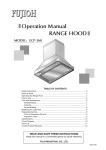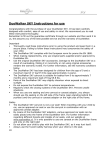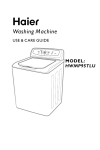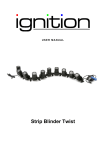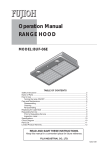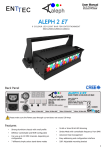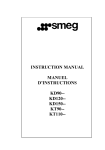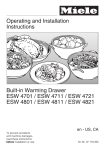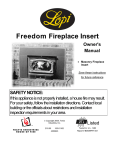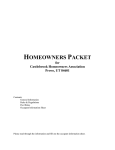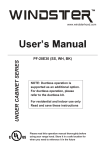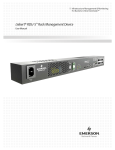Download Installation - Quality Craft
Transcript
stainless steel range hood Model#: 654OSA008STS Installation Guide and User Manual Please read and save this guide before using your range hood. Store the guide in a safe place so you will know where it is when you want to refer to it. IMPORTANT Carefully check the unit prior to installation to ensure there is no damage. Do not dispose of any packaging until you are satisfied with your new range hood. If you have any problems with this unit or there are missing or damaged parts, please call toll free: 1-800-459-4409 DO NOT RETURN THE UNIT TO THE PLACE OF PURCHASE before calling the toll free number above. • Read and save these instructions. Save this guide for local electrical inspector’s use. • Approved for residential appliances. • For residential use only. Installation must comply with all local codes. • Requirement: 120V AC, 60Hz. 15 or 20 A Branch Circuit. • Read all instructions before proceeding. • Turn off power circuit breaker before wiring this appliance. Installer: Must leave instructions for this unit with owner. Homeowner: Please retain these instructions for future reference and for local electrical inspector’s use. 2 IMPORTANT SAFETY INSTRUCTIONS Read all instructions before installing and operating this appliance. Installation Do not install if the appliance is damaged. 1.The instructions in this manual are intended for qualified installers, service technicians or other qualified persons. NEVER attempt to install this appliance yourself. 2.Installing the unit without an electrical and technical background could result in injury. 3.All electrical wiring must be properly installed, insulated and grounded. Old duct work should be cleaned or replaced if necessary to avoid the possibility of a grease fire. Check all joints on duct work to insure proper connection. All joints should be properly taped. 4.Personal injury hazard. Because of the weight and size of the range hood, two or more people are needed to move and safely install the range hood. Failure to properly lift range hood could result in damage to the product or personal injury. 5.SEVERE INJURY - Range hood may have very sharp edges. Please wear protective gloves to remove any parts for installing, cleaning or servicing. 6. DO NOT INSTALL CLOSER THAN 61 CM (24 INCHES) ABOVE COOKING SURFACE. Operations 1.Read all instructions in this manual before operating the appliance. 2.Always leave safety grills and filters in place. Without these components, operating blowers could catch on to hair, fingers and loose clothing. 3.NEVER dispose of cigarette ashes, ignitable substances, or any foreign objects in blowers. 4.NEVER leave cooking unattended. Use caution when cooking with oil. Overheating may cause oil to reach its flash point and ignite. Used oil will ignite at lower temperatures than fresh oil. 5.NEVER cook over open flames under the range hood. Constantly monitor deep-fryers during use, as overheated oil may ignite. 3 Cleaning Do not operate blowers when filters are removed. 1.The saturation of greasy residue in the blower and filters may cause increased flammability. Keep this appliance clean and free of grease and residue build-up at all times to prevent possible fires. 2.Filters must be cleaned periodically and kept free from accumulation of cooking residue (see cleaning instructions inside). Old and worn filters must be replaced immediately. 3.NEVER disassemble parts to clean without proper instructions. Parts should be disassembled by qualified persons only. The manufacture and distributors decline all responsibility in the event of failure to observe the instructions given here for installation, maintenance and suitable use of the product. The manufacturer and distributors further decline all responsibility for injury due to negligence and the warranty of the unit automatically expires due to improper maintenance. Workman Safety Gloves Safety Note: Remove PVC film before installation. Always wear “Safety Workman Gloves” for installation, cleaning, light bulb changing and dismantling to reduce the risk of injury. 4 BEFORE YOU START... It is very important for your safety and the safety of others that you follow the many important safety messages in this manual and on your appliance. Always read and obey all safety messages. All safety messages will tell you what the potential hazard is, how to reduce the possibility of injury, and what can happen if the instructions are not followed. This safety alert symbol alerts you to potential hazards that can kill or hurt you and others. All safety messages will follow the safety alert symbol and the word “WARNING.” READ AND SAVE THESE INSTRUCTIONS WARNING : TO REDUCE THE RISK OF FIRE, ELECTRIC SHOCK, OR INJURY TO PERSONS, OBSERVE THE FOLLOWING CAREFULLY: 1) Use this unit only in the manner intended by the manufacturer. If you have any questions, contact the distributor, importer or the manufacturer. 2) Before servicing or cleaning the unit, switch power off at the junction box and lock the panel door to prevent power from being switched on accidentally. If the junction box door cannot be locked, securely fasten a prominent warning sign to the panel door. 3) Installation work and electrical wiring must be done by qualified person(s) in accordance with all applicable codes and standards, including fire-related construction. 4) Sufficient air is needed for proper combustion and exhausting of gases through the flue (duct cover) of fuel burning equipment to prevent back drafting. Follow the heating equipment manufacturer’s guidelines and safety standards such as those published by the National Fire Protection Association (NFPA) and the American Society for Heating, Refrigeration and Air Conditioning Engineers (ASHRAE), and the local code authorities. 5) When cutting or drilling into the wall or ceiling, do not damage electrical wiring and hidden utilities. 6) Ducted fans must always be vented to the outdoors. 5 WARNING: To reduce the risk of fire, use only metal duct work. CAUTION: For general ventilation use only. Do not use the range hood fans to exhaust hazardous or explosive vapours. WARNING : To reduce the risk of injury in the event of a range top grease fire, observe the following: (Based on “kitchen fire safety tips” published by the NFPA) 1) SMOTHER FLAMES with a close-fitting lid, cookie sheet, or metal tray, then turn off the burner. BE CAREFUL TO PREVENT BURNS. If the flames do not go out immediately, EVACUATE AND CALL THE FIRE DEPARTMENT. 2) NEVER PICK UP A FLAMING PAN - you may be burned. 3) DO NOT USE WATER, including wet dishcloths or towels - a violent steam explosion will result. 4) Use an extinguisher ONLY if: a)You know you have a class ABC extinguisher, and you already know how to operate it. b)The fire is small and contained in the area where it started. c)The fire department is being called. d)You can fight the fire with your back to an exit. CAUTION: To reduce risk of fire and to properly exhaust air, be sure to vent air outside - do not vent exhaust air into spaces within walls, ceilings, attics, crawl spaces, or garages. WARNING: To reduce the risk of fire or electric shock, do not use this hood with any external solid state speed control device. 6 WARNING: FOR GENERAL VENTILATION USE ONLY. DO NOT USE THIS RANGE HOOD TO VENTILATE HAZARDOUS OR EXPLOSIVE MATERIAL AND VAPOURS. TO REDUCE THE RISK OF A RANGE TOP GREASE FIRE: 1) Never leave range unattended when in use. 2) Boil overs cause smoking and greasy spillovers that may ignite. 3 Heat oils slowly on low or medium setting. 4) Always turn hood ON when cooking at high heat or when cooking flaming foods (i.e. Crepes Suzette, Cherries Jubilee, Peppercorn Beef Flambe). 5) Clean ventilation fans frequently. 6) Grease should not be allowed to accumulate on fan or filters. 7) Use proper pan size. 8) Always use cookware appropriate for the size of the surface element. To get the best performance, the vertical clearance between the cook-top and the range hood should range from 61 cm - 76.2 cm (24 in. to 30 in). GROUNDING INSTRUCTIONS This appliance must be grounded. In the event of an electrical short circuit, grounding reduces the risk of electric shock by providing an escape wire for the electric current. WARNING: Improper grounding can result in a risk of electric shock. Consult a qualified electrician if the grounding instructions are not completely understood or if doubt exists as to whether the appliance is properly grounded. CAUTION: The range hood has a thermally protected system for the motor, which will shut down automatically if the motor is overheated. If the overheat protection trips, disconnect the power and wait for 10 minutes until the motor cools down. 7 ELECTRICAL REQUIREMENTS OBSERVE ALL GOVERNING CODES AND ORDINANCES IMPORTANT: It is the customer’s responsibility to contact a qualified electrical installer and assure that the electrical installation is adequate and complies with the National Electrical Code, or CSA standards and all local codes and ordinances. WARNING * Electrical grounding is required for this range hood. * Check with a qualified electrician if you are not sure whether the range hood is properly grounded. * Failure to follow electrical requirements may result in a fire. * A fuse in the neutral or grounding circuit could result in electrical shock. * If the hot/cold water pipe is interrupted by plastic nonmetallic gaskets or other materials, DO NOT use for grounding. * * DO NOT ground to a gas pipe. 1. Save installation instructions for electrical inspector’s use. 2. If codes permit and a separate ground wire is used, it is recommended that a qualified electrician determine if the ground path is adequate. 3. DO NOT use an extension cord or adapter plug with this appliance. 4. RISK OF ELECTRICAL SHOCK - This range hood must be properly grounded. 5. The range hood must be connected with copper wire only. 6. The range hood should be connected directly to the junction (or circuit breaker) box through flexible, armoured or nonmetallic sheathed copper cable. Allow some slack in the cable so the appliance can be moved if servicing is ever necessary. 7. A UL listed or CSA approved conduit connector must be provided at each end of the power supply cable (at the range hood and at the junction box). 8 8. When making the electrical connection, cut a 3.2 cm (1-1/4 in.) hole in the wall. A hole cut through wood must be sanded until smooth. A hole through metal must have a grommet. 9. When cutting or drilling into the wall or ceiling, do not damage electrical wiring and other hidden utilities. 10.Wire sizes must conform to the requirements of the National Electrical Code ANSI/NFPA 70 - latest edition*, or CSA Standards C22.1-94, Canadian Electrical Code Part 1 and C22.2 No. 0-M91 latest edition** and all local codes and ordinances. 11.Connect Black to Black, White to White and Green to Green wires from the range hood to the house wiring and cap with wire connectors. Range hood wiring BLACK ( Live ) WHITE ( Neutral ) GREEN/YELLOW ( Ground ) White (N) Black (L) Wiring from electrical source Yellow/Green (G) WARNING ELECTRICAL SHOCK HAZARD Do not perform service on an electrically live system. Disconnect the main electrical supply before servicing this device. Touching electrical connectors or other exposed electrical circuitry inside this range hood when they are energized could result in death, serious bodily injury, or property damage. * National Fire Protection Association Batterymarch Park Quincy, Massachusetts 02269 ** CSA International, 178 Rexdale Boulevard, Toronto, Ontario, CANADA, M9W 1R3 9 LIST OF MATERIALS TOOLS FOR INSTALLATION: utility knife level measuring tape marker or pencil tape powered screwdriver or drill flat-blade screwdrivers adjustable wrench Philips screwdrivers hammer Notice: 1.Remove the range hood from the carton packaging and place on a flat surface for assembly. 2.Check carefully to ensure there are no missing parts or mounting hardware. 3. When installing, cleaning or performing maintenance, it is recommended wearing safety glasses and safety gloves. 4. WARNING: To avoid danger of suffocation, keep the plastic that covers the unit away from children. Do not use in cribs, beds, carriages or playpens. The bag is not a toy. Discard bag and all other packing materials immediately after removing the unit. Do not reuse the bag. 10 SUPPLIED PARTS: Description Qty. Range Hood (with 2 filters) 1 Damper (located inside the hood) 1 ø4 mm x 8 mm tapping screw 2 ø5 mm x 30 mm tapping screw 4 Installation Guide 1 installation guide range hood x 1 ø5 mm x 30 mm tapping screw x 4 ø4 mm x 8 mm tapping screw x 2 damper x 1 11 PLANNING FOR INSTALLATION WARNING * Proper installation is your responsibility - Have a qualified technician install this range hood. * Read the entire installation guide and user manual thoroughly, and understand instructions and warnings. * PERSONAL INJURY HAZARD - Because of the weight and size of the range hood, two or more people are needed to move and safely install the range hood. Failure to properly lift range hood could result in damage to the product or personal injury. * All openings in ceiling and wall where range hood will be installed must be sealed. * Range hood location should be away from strong draft areas (windows, doors and strong heating vents). * SEVERE INJURY - Rotating fan can cause severe injury. Stay clear of fan when motor is running. * SEVERE INJURY - Range hood may have very sharp edges. Please wear protective gloves to remove any parts for installing, cleaning or servicing. DIMENSIONS: 30.5 cm (12 in) 12.7 cm (5 in) 6.5 cm (2.5 in) 45.8 cm (18 in) 75.7 cm (29.8 in) MEASUREMENTS: This product is designed for under cabinet installation. Before installation, measure all distances to ensure the proper position of the range hood. 1) Distance from the floor to the ceiling. 2) Distance between the floor to the counter top/stove. 3) Distance between the counter/stove and range hood 61 cm to 76.2 cm (24 in to 30 in). For optimal performance, the range hood should not be installed more than 76.2 cm (30 in) from cooktop. 4) Height of cabinet. 5) Height of the range hood installation location. 6) Determine if your existing venting system is top or back venting before any installation begins. 12 DO NOT INSTALL CLOSER THAN 61 CM (24 INCHES) ABOVE COOKING SURFACE Range Hood Ceiling Height Min: 61 cm (24 in) Max: 76.2 cm (30 in) Appox. 91.4 cm (36 in) OPERATION TEST: Before permanently mounting the range hood, temporarily wire the range hood and test for proper operation. If the rangehood is not operating correctly do not continue with the installation. PREPARE HOOD LOCATION: If the bottom of the cabinet is recessed, add wood filler strips on each side. The wood strips must be as thick as the recess. Using appropriately sized wood screws, attach filler strips in the locations shown. (Bottom View) Wood Filler Strips Cabinet Bottom 13 Wall OUTDOOR VENTING METHODS: This range hood can be top or back vented. Check to see which venting method you have. If this is a new installation, choose which venting method suits your needs. NOTE: Before making any cuts or holes for installation, carefully measure and mark all measurements. Double check all measurement markings before cutting. Cut-out the openings for damper and power access hole, in the cabinet bottom or exterior wall, depending on the direction of venting chosen. See figures below. Top Venting Option Centerline 28.5cm 10cm 11.8cm 2.8cm 13cm 13cm 2.2cm 3.9cm dia. hole Measurement conversions: 1 cm = 3/8 in 2.2 cm = 7/8 in 2.8 cm = 1 1/8 in 10 cm = 3 15/16 in 11.8 cm = 4 3/4 in 13 cm = 5 1/8 in 3.9 cm = 1 1/2 in 20 cm = 3/4 in 28.5 cm = 11 1/4 in Back Venting Option Centerline 1cm 2cm 10cm 14 2.2cm dia. hole 13cm 13cm 28.5cm IMPORTANT: - Vent system must terminate outdoors (through roof or side wall). - Do not terminate the vent system in an attic or any other enclosed area. - Use only metal/flexible aluminum vents. - Never use plastic vents. - Always keep ducts clean to ensure proper air flow. - NEVER exhaust air or terminate duct work between walls, crawl spaces, ceilings, attics or garages. All exhaust must be vented to the outdoors. - Use caulking to seal exterior wall or roof opening around the cap. - Do not use 10.2 cm (4 in.) laundry-type wall caps. - It is recommended that the range hood be vented vertically through the roof through 15 cm (6 in.) round metal/aluminium vent work. The size of the vent should be uniform. - Use no more than three 90 degree elbows. Do not install two elbows together. - Make sure there are a minimum of 61 cm (24 in.) of straight vent between the elbows if more than one elbow is used. The length of the vent system and number of elbows should be kept to a minimum for effective performance. - The vent system must have a damper. If roof or wall cap has a damper, Do not use damper supplied with the range hood. - Use duct tape to seal all joints in the vent system. - Fasten all connections with sheet metal screws and tape all joints with certified Silver Tape or Duct Tape. Example 1. Vertical roof venting Example 2. Horizontal wall venting Roof cap Roof Cabinet Range hood Pipe Damper Ducting through the roof Cabinet Damper Range hood Pipe Wall cap Wall Ducting through the wall 15 Calculate the duct run length: If ducted with the required minimum of 15 cm (6 in.) round duct work, the duct run should not exceed 10.7 m (35 ft.). Calculate the length of the duct work by adding the equivalent feet as below for each piece of duct in the system. If you must elbow right away, do it as far away from the hood’s exhaust opening as possible. 45o Elbow 91.4 cm (36 in.) 90 Elbow 1.52 m (60 in.) o 90 Flat Elbow o Wall Cap 16 3.66 m (144 in.) 0 cm (0 in.) 2.74 m (9 ft.) Straight Duct 2.74 m (108 in.) 2-90 Elbow 3.05 m (120 in.) o Wall Cap Total System 0 cm (0 in.) 5.79 m (228 in.) INSTALLATION INSTRUCTIONS - Before making cuts, make sure there is proper clearance within the ceiling or wall for exhaust vent. - Check your ceiling height and the hood height before you install your range hood. The hood installation height above the cook top can vary slightly. A lower hood ensures more effective capture of cooking odours, grease and smoke. However, the hood should be installed a minimum of 61 cm (24 in) and a maximum of 76.2 cm (30 in) above the range top. - Screws are provided to secure the range hood to most types of cabinets. You should consult a qualified installer to verify that the supplied screws are suitable for your cabinets. - The manufacturer assumes no responsibility for injury and/or damage caused by improper installation. - Put a thick, protective covering over your counter top, cook top or range to protect from damage and dirt. Remove any hazardous objects around the area when installing. WARNING • TURN OFF ALL POWER: Ensure all power is turned off at the main electrical box before commencing installation. • TURN OFF ALL GAS: If you are installing above a gas range, the gas must be turned off at the source. 1.Determine the venting method (vertical top venting or horizontal back venting). 2.Use a hammer and flat tipped screwdriver to gently punch out the appropriate electrical knock-out hole (figure 1). Be very careful not to leave any broken pieces inside the range hood. Electrical knock-out hole Fig. 1 17 3.Using a flat tipped screw driver, remove the appropriate knock-out for your installation type (fig. 2). Top Venting Back Venting Fig.2 4.Install the damper with two 4mm x 8mm tapping screws (figure 3). If this hood replaces an existing unit, the location of the air exhaust can vary from one manufacturer to another. Make sure the damper fits in the existing opening before installing. Top Venting Option Back Venting Option Above the Steel Under the Steel Hole 2 x øX4mm x 8mm screws 3 Damper Goes into the hole 2 2 x øX4mm Damper x 8mm screws Hole Fig.3 18 1 Hole 5.Seal the damper to the hood using duct tape (figure 4). Fig.4 6.Turn the hood upside down on a protective covering such as cardboard or a large towel. Remove the 2 aluminum filters and bottom panel. (a) Remove the aluminum filters by pulling the handles. (b) Remove the bottom panel by removing the 6 screws (figure 5). (c) Ensure you have a good grip on the bottom panel when removing the screws so it does not fall into the unit. Fig.5 7.Lift the range hood up under cabinet and determine final position. Mark the location of the four keyhole mounting slots. Set range hood aside on a protected surface (figure 6). Drill 4 pilot holes in the marked positions. Keyhole slot Drill pilot hole Fig. 6 19 8.Screw the four Ø 5 mm x 30 mm tapping screws into the pilot holes. Leave screw heads about 7 mm (0.28 in) from the cabinet surface (figure 7). 7mm (0.28 in) Fig.7 9.Lift range hood into position, feeding electrical wires through wiring opening. Position the range hood so the large end of the keyhole slots are over the screws. Push the hood toward the wall so the screws are in the neck of the slots. Tighten the screws to secure the range hood to the cabinet. Check to ensure all 4 screws are situated in the narrow portion of the keyholes. Test the damper blade to ensure it rotates up and down freely (figure 8). Keyhole neck Keyhole slot Fig.8 CAUTION: ENSURE THE RANGE HOOD IS SECURELY ATTACHED TO THE CABINET BEFORE RELEASING. 10. Connect vent work to hood and seal joints with duct tape, ensuring an air tight fit. When cutting or drilling into walls or ceilings, do not damage electrical wiring and hidden utilities. 20 11. Connect the electrical wires from the range hood to the house wiring. Make sure you read and understand the electrical requirements section at the beginning of this manual. WARNING: All wiring should be done by or approved by a qualified electrician. Before doing any electrical work, make sure wires do not slip between any moving parts to prevent any damage. 12. Install the bottom panel and aluminium filters. Turn the power on and check all lights and fan operation. 21 MAINTENANCE Prior to any maintenance operation ensure that the range hood is disconnected from the power supply. WARNING ELECTRICAL SHOCK HAZARD Do not perform service on an electrically live system. Disconnect the main electrical supply before servicing this device. Touching electrical connectors or other exposed electrical circuitry inside this range hood when they are energized could result in death, serious bodily injury, or property damage. Cleaning range hood surface: - The range hood should be cleaned regularly internally & externally in order to preserve its fine appearance and optimal level of operation. - Always clean in the direction of orginal polish lines. - Always rinse well with clean water two or three times after cleaning. Wipe completely dry with a soft non-abrasive cloth. - Clean periodically with hot soapy water and a clean cotton cloth. - After cleaning, you may use non abrasive stainless steel polish/cleaner, to polish. Always rub lightly and with the grain. - Make sure the ducting system is free of debris. - DO NOT let plaster dust or any other construction residue enter the hood. During construction or renovation, cover the hood. - DO NOT use corrosive or abrasive detergents, steel wool or scouring pads. These will scratch and damage the stainless steel surface. - DO NOT allow deposits to remain for long periods of time. Rinse with water after exposure and wipe dry with a clean cloth. - DO NOT leave the hood unclean for long periods or allow dirt to accumulate. 22 Detergents: - DO NOT use corrosive or abrasive detergents or any products containing chloride, fluoride, iodide, bromide to the product, as it will deteriorate the surface rapidly. - DO NOT allow cleaning compounds, salt solutions, disinfectants or bleaches to remain in contact with the product for extended periods. - Any combustible products used for cleaning such as acetone, alcohol, either, benzol, etc., are highly explosive and should never be used close to a range. Cleaning aluminium filters: - The filters fitted by the factory are intended to filter out residue and grease from cooking. It need not be replaced on a regular basis but are required to be kept clean. - Do not accumulate oil over 80% of the filter surface to avoid oil dropping on range. - The filters must be cleaned once a month using non abrasive detergents, either by hand or in the dishwasher. Set dishwasher to a low temperature and a short cycle setting. - When washed in a dish washer, the grease filter may discolour slightly, but this does not affect its filtering ability. - Dry filters and re-install before using hood. WARNING: Failure to carry out the basic standards of cleaning of the range hood and replacement of the filters may increase the risk of fire. We therefore recommend that you follow these instructions. Replacing Filters: - Should filters wear out due to age or prolonged use, replace with an aluminum grease filter (with stainless steel clips). - Note: Also replace a damaged filter that has punctures or a bent or broken frame. Replacing light bulbs: WARNING BURN HAZARD Light bulbs can become extremely hot when turned on. DO NOT touch bulb until switched off and cooled. Touching hot bulbs could cause serious burns. SEVERE INJURY Rotating blower fan can cause severe injury. Stay clear of fan when motor is running. WARNING: Disconnect range hood from electrical source and be sure lights are cool. Should the light bulb burned out due to age or prolonged use, replace with MAX. 25W/JDR 16, GU10 twist and lock base lamps. If new lights do not operate, make sure the light bulb is inserted correctly. 23 1.Turn off the range hood. 2. Make sure the lights are cool to touch, use a flat hand screwdriver or equivalent tool carefully turn the inner ring counter-clockwise to pop out the protective covering of the light. 3.Gently pull out the defective bulb and discard accordingly. 4.Install a new halogen light bulb and reverse the steps. Rotate anti-clockwise and pull out to remove Rotate clockwise and push in to install OPERATION Power Switch Low Speed Medium Speed High Speed Light Switch TURN ON: 1.Press the speed control switch (Low Speed, Medium Speed, High Speed) to select the desired level of power. Once a button is pressed, the previous speed mode will be canceled. 2.Press the Light Switch to turn on the lights. TURN OFF: 3.Press the Power Switch to turn off the power (fan only). 4.Press the Light Switch to turn off the lights. Note: The fan and the lights are operated independantly of each other. TROUBLE SHOOTING 24 1.If the range hood does not operate after installation: - Check if all power has been turned back on and all electrical wiring is properly connected. - Check that the power connection for the unit is properly connected. - Make sure the wiring between the switch board and control board are connected properly. 2.The range hood vibrates when the blower is on: - The range hood might not have been secured properly to the wall. - Check if the motor is secured in place. If not, then tighten the motor in place. - C heck if there is a damaged blower wheel. If so change the blower wheel. 3.The blowers seems weak: - Check that the duct size used is at least 15.2 cm (6 in.). Range hood WILL NOT function efficiently with insufficient duct size. For example: 17.8 cm (7 in.) duct cover 15.2 cm (6in.) holes and loosely secured. - Check if duct is clogged or if damper unit is not opening properly. A tight mesh on a side wall cap unit might also restrict air flow. 4.The lights work but the blower is not spinning, is stuck or is rattling: - The blower might be jammed or scraping the bottom. - The motor is defective, possibly seized - change the motor. - The thermal protection system detects if the motor is too hot to operate and shuts the motor down. In this case the motor will function properly after the thermal protection system cools down (approx. 10 min.). 5. The hood is not venting properly: - Make sure the distance between the cook top and the bottom of the hood is between 61 cm (24 in) and 76.2 cm (30 in). - Reduce the number of elbows and length of duct work. Check if all joints are properly connected, sealed and taped. - Make sure the power is on high speed for heavy cooking. - Wind from opened windows or doors in the surrounding area are affecting the ventilation of the hood. Close all windows and doors to eliminate the outside air flow. - Check if the direction of duct opening is against the wind. If so, adjust the direction of the duct opening. - Check if the wrong size of ducts are being used. 6. The light does not work: - Check to see if light bulb is loose. If so, tighten - R emove problem bulb and insert one you know is working. If the properly functioning light does not come on, the problem may be the light assembly. Service or replace the light assembly. NOTE: For all other inquiries, please contact us. 25 WIRING DIAGRAM MAX 25W/JDR 16 GU10 Light Yellow & Green Motor White Capacitor 10µ F/370V Brown Black Gray Black Yellow Blue White Black Black Green Black Red Yellow Yellow & Green White Black Grey 757mm (29-13/16 in) 706mm (27-3/4 in) 28mm 250mm (9-13/16 in) (1-1/4 in) 18mm (11/16 in) 22mm (7/8 in) dia. hole 80mm (3-1/8 in) 93.5mm (3-11/16 in) 39mm (1-1/2 in) 305mm (12 in) 270mm (10-5/8 in) 110mm (4-5/16 in) 50mm (2 in) SPECIFICATIONS 50mm (2 in) 458mm (18 in) TOP VIEW 10mm (3/8 in) 26 BACK VIEW 20mm 250mm (9-13/16 in) (3/4 in) 22mm (7/8 in) dia. hole 80mm (3-1/8 in) 95.3mm (3-11/16 in) 757mm (29-13/16 in) 127mm (5 in) PARTS Damper Control Switch Hood body Light Light Fan Motor Bottom Panel Safety Net Aluminium Filters 27 1-YEAR HOME USE WARRANTY This product is warranted to the original purchaser to be free of defects in material and workmanship for one (1) year from the date of purchase. This warranty does not extend to commercial or institutional use or installation. Warranty service should be arranged through the point of purchase. The purchaser is responsible for transporting the unit to and from the point of purchase. Incidental repairs that would involve a minimum of time and effort on behalf of the purchaser will not be considered warranty work and no compensation will be deemed forthcoming. Any failure of the unit that is not traceable to a defect in material or workmanship is not covered by this warranty. These non-warrantable items include, but are not limited to: • Change in colour or finish due to chemical usage • The use of abrasive cleansers • Improper maintenance resulting from failure to reasonably clean, care for or maintain a product in accordance to Quality Craft’s cleaning instructions • Unit not properly installed in accordance with manufacturer’s instructions • Damage caused during shipping, handling or installation • Operating, maintenance, safety guidelines not being followed • Any alterations to the unit • Damage to the unit as a result of accidental impact, fire, flood, freezing, normal wear • Light bulbs are not covered by this warranty • Scratches, chips, cracks or holes caused by shipping, storage or installation A thorough inspection must be made at time of pick up or delivery. If the unit is damaged, a claim must be made with the carrier. Report any damage promptly and prior to installation. Quality Craft Ltd. will not be held liable for any freight damage or damage caused by leaks due to freight damage. Inspection prior to installation is the responsibility of the installer, contractor or user. Quality Craft Ltd. will not be liable for failures or damage that could have been discovered or avoided by proper inspection and testing. Quality Craft Ltd. will not be held liable for damages resulting from the improper fit or installation of products not supplied by this company. Quality Craft Ltd. will not be held liable for loss of use of unit, inconvenience, costs incurred for labour, materials, removal and installation of replacement units or any other incidental or consequential damages. Costs relating to obtaining access for repair or replacement are the responsibility of the user. Under no circumstance shall Quality Craft Ltd. or any of its representatives be held liable for injury to any persons or damage to any property. Quality Craft Ltd.’s obligations shall be limited to the repair or replacement of a unit (at our option) that may prove, by our sole examination, to be defective under normal use and service during the warranty period. The Company may issue credit in the amount of the invoice value of the defective product (or a percentage of it according to use) in lieu of repair or replacement. All replacements FOB Quality Craft Ltd. nearest service depot. Quality Craft Ltd. warranty is non-transferable and shall be voided if the unit is removed from its initial installation or if it is not installed following the manufacture’s specifications. This warranty shall not apply to any product that has been subject to accident, alteration, misuse, abnormal chemical conditions. This warranty is made in lieu of all other warranties expressed or implied. No other warranty, expressed or implied, is assumed or will be assumed. Imported by Quality Craft Kitchen & Bath Ltd. 2436 Industriel Blvd., Laval, Quebec, Canada, H7S 2G7 TOLL FREE TEL: 1-800-459-4409 www.qualitycraft.com Made in China
































